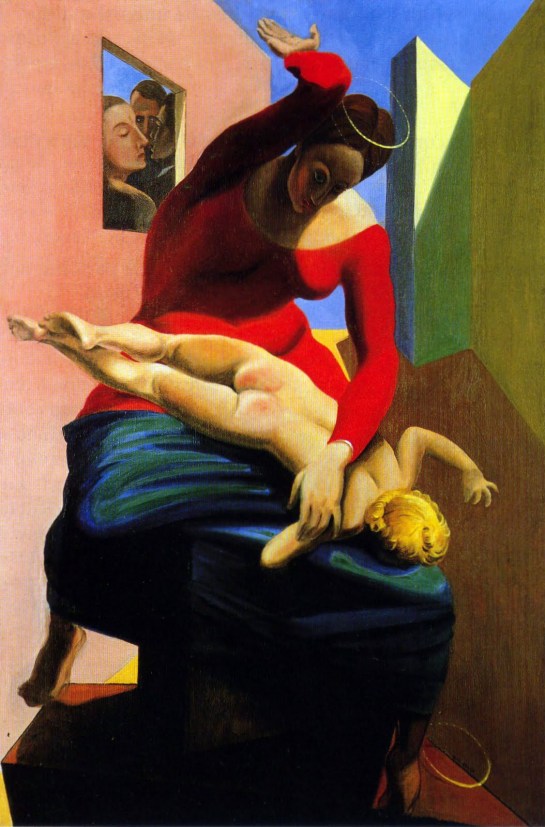The painting entitled Young Virgin Spanking the Infant Jesus In Front of Three Witnesses is a controversial work by Max Ernst. It depicts the Virgin Mary spanking Jesus as an infant in view of Ernst, Andre Breton, and Paul Elard. It is no wonder that such a painting would be considered controversial concerning the time period that it was produced. This is due to the subject matter. The depiction of Christ being spanked undermined a traditional belief in one of the most popular religions in the world. Ernst depicted this image in retaliation of his father and the Catholic Church which Ernst saw as oppressors in his early life.
Ernst originally saw his father as a role model and aspired to pick up painting because it was his father’s hobby. Their relationship changed rapidly upon the death of Ernst’s’ older sister Maria.[1] He associated her death as that of a corrupt divine will, and due to his father’s association with the Catholic Church, it did not take much for Ernst to see his father as an assassin of his sister. Ernst possessed an active imagination which allowed him to make these types of connections. The death of his sister shut down an outlet for the young Ernst to express himself and his imagination which only added to his frustrations.[2] These frustrations with the church and his father would be displayed later in life through works such as Young Virgin Spanking the Infant Jesus In Front of Three Witnesses in which Ernst expressed the angst that he felt against these authority figures.
The subject matter of this painting is what lends itself to much controversy. In the Christian faith, Jesus is the representation of God on Earth. This means that Jesus was a perfect man who committed no sins. This painting shakes the foundations of this religion by depicting its most important symbol as an imperfect child who must be scolded for his misbehavior. This act of reprisal is also justified due to the usage of symbolism by depicting Mary’s halo still over her head while the infant Christ’s crown lies on the ground. He has thus fallen from grace and is instead a normal human and no longer a deity. This is all done while the artist and his friends watch in interest at the ongoing process. Ernst is projecting a direct challenge to society to reevaluate its ideas on long held traditions. It created a spark that propelled Ernst into the spotlight due to the sensitivity of the subject that was portrayed.
One other interesting feature that Max Ernst adds to this painting is the depiction of reddening on the child’s bottom and upper legs. This is to suggest that the Virgin is not administering a light punishment, but she is instead giving a vicious reprimand. This is more than likely a depiction of the types of punishment that Ernst himself experienced as a child. Ernst sought to convey the punishment as intentional and severe by highlighting the affected areas.
This scene displays the dreamlike imagery which harkens back to that of de Chirico. Ernst provides this feeling in the ways that the building around the virgin is shaped. The house is shaped in non realistic ways and shown from different perspectives. Walls are drawn so that they appear to be at sharp angles that do not allow the viewer to see where exactly they are standing in the house. This element adds a sense of confusion which possesses a menacing quality as the painting is observed over time. The confusion added by the setting helps add to the unsettling subject of the painting.
Max Ernst was able to depict his life experiences in ways that openly challenged society’s traditions with Virgin Spanking the Infant Jesus In Front of Three Witnesses. Depicting the Christ child being reprimanded is a perfect subject because it shows people a different view of what they are told by others. It not only displayed what Ernst experienced but denounced what he felt was the root cause of his anger. This painting helped to establish Max Ernst at the forefront of the Surrealist movement by addressing such a controversial topic in the dreamlike manner common among the movement.
References
Russell, John. Max Ernst: Life and Work. New York: H.N. Abrams, 1967.
